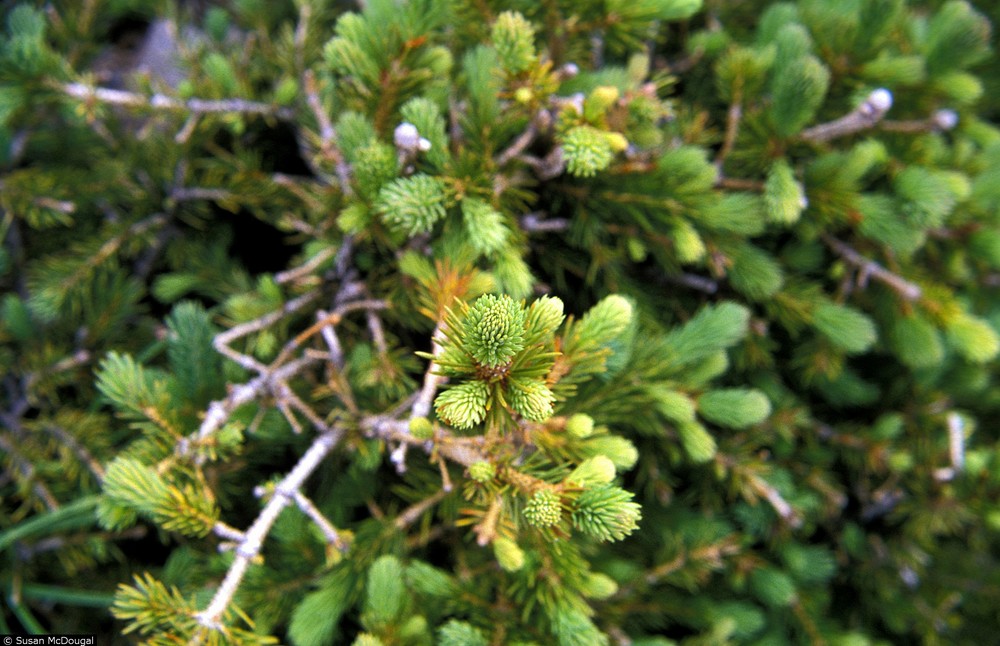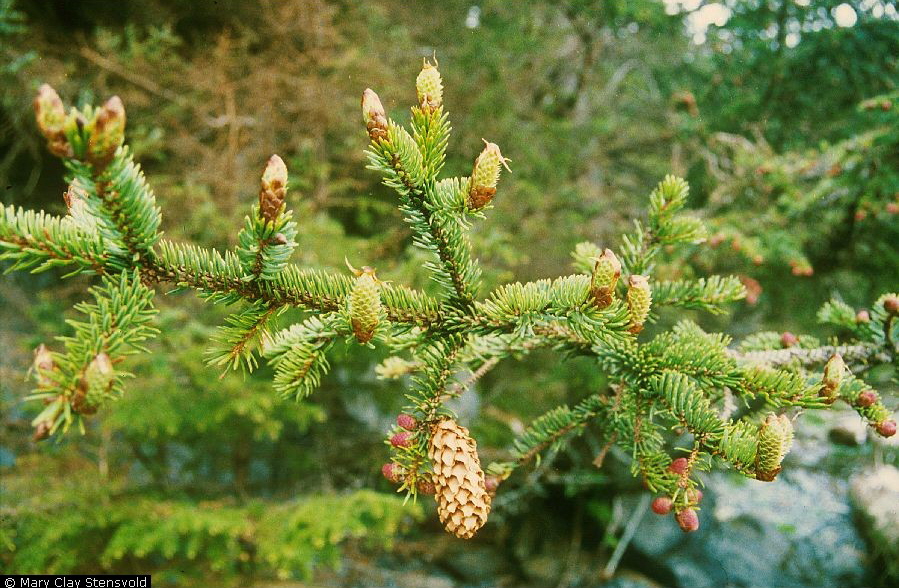With its stiff, sharp-pointed needles and scaly bark, Engelmann spruce are hard to miss among the firs and hemlocks of Oregon's forests. Moisture-loving trees, they can form nearly pure stands in high-elevation wet areas such as bogs, streamsides, and margins of wet meadows. Its shallow root system can be Engelmann spruce's figurative and literal downfall, since it is very susceptible to blowdown by wind.
The Engelmann spruce (Picea engelmannii) is also known as Columbia, white, mountain, or silver spruce. Picea refers to the ancient Latin word for pitch. The specific epithet honors George Engelmann (1809-1884), St. Louis physician and botanist.
Engelmann spruce grows in the Rocky Mountains from central British Columbia south to Mexico and in the Cascade Mountains of Washington and Oregon, with a few scattered populations in northern California, the Siskiyou Mountains, northeastern Oregon, and the Olympic Mountains of Washington State.
The species grows in moist, cool, mountain habitats, and in Oregon is found mostly above 4,000 feet in the Cascade Mountains. The trees can reach considerable size. The Oregon champion is in Union County, where an Engelmann spruce reaches 190 feet tall and 5.6 feet in diameter.
Native Americans used Engelmann spruce as a medicine and a tea, and they used the wood for building materials. Today, Engelmann spruce is made into prefabricated wood products and plywood. With long, light-colored fibers and no resin, it is valued as paper pulp.
The Engelmann spruce also has a more aesthetic use. Makers of stringed musical instruments seek quarter-sawed spruce wood for soundboards because of its ability to produce a powerful, direct tone.
-
![Engelmann spruce (Picea engelmannii Parry ex Engelm.).]()
Englemann spruce branch.
Engelmann spruce (Picea engelmannii Parry ex Engelm.). Photo by Susan McDougall, USDA-NRCS PLANTS Database
-
![Engelmann spruce (Picea engelmannii Parry ex Engelm.).]()
Englemann spruce cones.
Engelmann spruce (Picea engelmannii Parry ex Engelm.). Photo by W.L. Wagner, USDA-NRCS PLANTS Database
-
![Engelmann spruce (Picea engelmannii Parry ex Engelm.).]()
Englemann spruce 2.
Engelmann spruce (Picea engelmannii Parry ex Engelm.). Photo by Susan McDougall, USDA-NRCS PLANTS Database
-
![Bark of Engelmann spruce (Picea engelmannii Parry ex Engelm.).]()
Englemann spruce bark.
Bark of Engelmann spruce (Picea engelmannii Parry ex Engelm.). Photo by Al Schneider, USDA-NRCS PLANTS Database
-
![Engelmann Spruce.]()
Englemann spruce.
Engelmann Spruce. Photo by Oliver V. Matthews, Oreg. State Univ. Archives, Oliver Matthews Coll., MatthewsScrapbook27
Related Entries
Further Reading
Arno, S.F. and R.P. Hammerly. Northwest Trees: identifying and understanding our native trees. Revised Ed. Seattle: Mountaineers 2007.
Jensen, E.C., C.R. Ross, Trees to Know in Oregon. Revised Ed. Corvallis: Oregon State University Extension Service 2005
Moerman DE. 1998. Native American Ethnobotany. Portland (OR) Timber Press. 927 p
Oregon Champion Tree Website, Oregon Department of Fish and Game.






